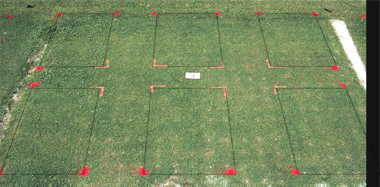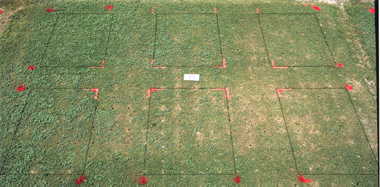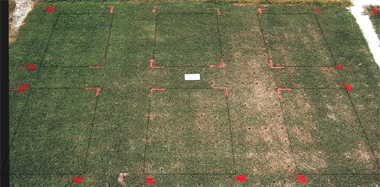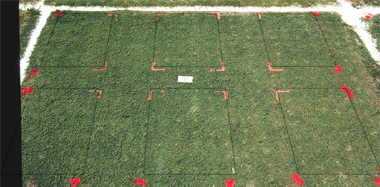|
 |
| The photographs were taken under cloudless conditions the
afternoon of 13 July, using a 35-mm lens, with Kodachrome 64 film, F-stop=11 and 1/125th
of second. Transparencies were scanned to 4-MB TIFF files with a Polaroid Scanner,
and the digital images opened in Adobe PhotoShop, tilted to parallel, brightness-adjusted
+35 units, contrast adjusted to +30 units, uniformly cropped, and sized to 380 pixels
width, and black plot borders added. PhotoShop files were optimized with Ulead
SmartSaver to JPEG quality level 60, no smoothing. |
|
Originating in Florida, this greens grass was implied to
be closest to the original Tifdwarf. The grass originated through Mr. Phil
Horn. It appears to have been grown commercially in the early 1990s. These
four replicated plots were planted at University of Florida - Fort Lauderdale in May/June
1993. Throughout most of their evaluation they were mowed at 1/8 inch. Plots
were aerified the week of 21 June 1999 and were treated with excess rates of herbicides 29
June 1999 and again 7July 1999, thus the cumulative rates were actually 2X, 4X, 6X, 8X,
and 10X. Mowing was suspended as soon as treatments began.
Classic Dwarf bermudagrass performed overall: Good (7.9) |
|
|
| Basagran T/O (top row 0X, 1X, and 2X; bottom row 3X, 4X,
and 5X). One of the better grasses in the replicate. |
 |
|
 |
| Illoxan 3EC (top row 0X, 1X, and 2X; bottom row 3X, 4X,
and 5X). Tight dwarf, slight injury. |
 |
|
 |
| MSMA 6.6 (top row 0X, 1X, and 2X; bottom row 3X, 4X, and
5X). Outstanding. |
 |
|
 |
| Primo (top row 0X, 1X, and 2X; bottom row 3X, 4X, and
5X). Nice grass. |
 |
|
|
|



